Gull Summit — Prime Minister concerned over Hitchcockian behavior

Scientists are hoping to "shrink" the seagull ‘menace’ in Cornwall and the rest of the Westcountry. Fearless gulls have been terrorizing visitors to the region in the past few years, snatching food from visitors' hands and even killing pets.
Now experts are hoping that a team of bird-brained psychologists will find the answers. West of England councils have long wrestled with the gull problem, with solutions ranging from gull-proof rubbish bags and high-tech pavement bins to a "dummy egg" scheme which fools the birds into thinking they are nesting. Failed methods also include plastic eagles and gulls, as well as noisy scarer devices.
Now a team from the University of the West of England will spend 18 months studying the psychology of seagulls.
They will map the interaction between humans and urban gulls in Bath and North East Somerset. The team will focus on the nesting sites of the birds, their feeding activity and how people respond to them. Dr Chris Pawson, head of psychology at UWE, said: "Existing measures used to control the gull population over the past decade or so have been largely ineffective.
"A better understanding of the motivations of the protected species is required to formulate a fresh approach.
"From a behavioural ecology point of view, many of the principles you call upon to explain human behaviour are exactly the same for wildlife. We need to know on what basis they are making their decisions and why they go to some areas and not others. By having these increased levels of data, ways we can shape their behaviour might emerge. We are open to all sorts of ideas. Interventions have not, to date, significantly lowered the population of gulls. Current levels are such that complaints are intolerably high for the environmental teams and for the councils."
Locals will also be invited to supply information about the birds' activity digitally. Surveys suggest that urban gull populations have more than doubled over the past 15 years. At the same time, the rural gull population has collapsed.
David Cameron, the Prime Minister, has said there needs to be a "big conversation" about gull numbers and the RSPB is calling for a "gull summit" to discuss the issue.
No screaming, we are the police

Police in the Netherlands kicked in a door in response to an emergency call - only to realize the "terrifying screams" that had been reported were actually the sound of a man singing along to opera.
A concerned neighbor called police to report domestic violence. Police officers who arrived at the property also heard screaming coming from inside. When they tried to break in, the man, wearing headphones, came to the door.
It happened on Tuesday in Buitenveldert, a southern area of Amsterdam.
Police released details of the incident in a Facebook post. They said everyone concerned had laughed about the matter. Some of the people commenting have suggested that the man should enter The Voice of Holland, a TV talent show.
The name of the man has not been released - nor has the name of the opera he was singing along with.
We shouldn’t laugh

It’s been going the rounds on Facebook, but if you haven’t seen it look at the graphic, make your own impressions, then let’s talk about us.
Putting aside possibly facetious explanations for the logo, like ‘he is helping him up,’ 157 to 55 residents of Whitesville, NY state couldn’t see anything offensive or didn’t care about their town’s logo which adorns their town seal which appears on police cars, official stationary and signposts. ‘White’ they say named the town, so it should be called Whitesville — apparently none of the residents asked the Abenaki what First People had called it for the previous 8,000 years.
But we shouldn’t laugh.
Brattleborough was named after a two-a-penny militia colonel who never even visited Vermont, and is the start of the Molly Stark Trail, with obelisks, going over route 9 to Bennington — Molly Stark never visited the state either, no doubt choosing the direct and convenient valley called The Pioneer Trail in Massachusetts leading directly to Bennington, so to attend to injured at the Battle of Bennington — which did not take place in Bennington but over the border in new York State. So much for origins.
Do we liberal and sensitive Vermonters know the name Abenaki people gave ‘Brattleboro’? I have been amusing myself thinking of other names for our town and how upset people will be when they read them.
Obviously Tofu-town is out of the question, especially since this is already our appellation in Montpelier [not a joke].
“Wanta—” appears to be an Abenaki prefix for “place,” so what sort of place is this? One interpretation of Wantastiquet is “place of the hidden valley” referring to the West River.
These days Wanta-Bagel is likely too promiscuously aggressive imported ethnic chic, even though 55% of Brattleburghers come from the NY City conurbation.
Perhaps we should have a competition?
All washed up

A large chunk of an American space rocket was found in the sea off the Isles of Scilly in November
In recent years, 100-year-old rubber-like blocks from Indonesia have been mysteriously washing up on beaches across the UK, including Cornwall
Hundreds of pieces of Lego have washed up on the beaches of Cornwall in recent years after a goods container fell off a ship in 1997.
In August, a hotelier on the Isles of Scilly was "amazed" to find a washed-up message in a bottle that travelled more than 4,000 miles (6,400km) from the Bahamas
The latest global product to wash up are these pink bottles of detergent on The Lizard peninsula, with the best beaches in the world. They started arriving at Poldhu Cove on the Lizard on Sunday, and National Trust volunteers have been clearing them away as they are said to pose a risk to wildlife. The bottles are sealed, but witnesses say some have leaked. The National Trust said it believed a container had gone overboard from a ship, during the stormy weather.
The Maritime and Coastguard Agency said: "While it is fact that the MV Blue Ocean lost a container containing bottles of 'Vanish', there is no currently available evidence that the bottles washed up on the Cornish coast are from this container; all evidence is currently circumstantial." It is thought the vessel lost the container near Land's End in May. The BBC has contacted Vanish, but the company is yet to comment. Other nearby coves including Gunwalloe, Polurrian, Church Cove and Marazion have also been affected, conservationists said.
Cornwall Council said the authority and partners, including the Maritime and Coastguard Agency and Natural England, would be monitoring beaches in the area. It said: "The National Trust who own the beach at Poldhu have arranged for the bottles to be cleared away. "In the meantime the public are advised to keep children and dogs at a safe distance from the bottles should any more be washed up. "No attempt should be made to recover the bottles."
Psycho Rabbit

A PET psychiatrist has been brought in to cure a bloodthirsty bunny with a bad attitude.
The drastic step has been taken in a last-ditch attempt to get Jack, a lop-eared rabbit, to buck up his ideas.
The six-month-old cuddly critter was brought into Maria's Animal Shelter in Probus, Cornwall, in October and the charity's founder, Maria Mulkeen, said he "looks like butter would not melt in his mouth".
But since Jack arrived his behaviour has gone from the odd nip of the heels to sustained attacks.
Mrs Mulkeen, 47, said: "One lady who volunteers at the shelter put down a carrot for him while he was running around the main room and he latched onto her hand and would not let go.
"Luckily we have a doctor who volunteers at the shelter and she was able to treat the hand with butterfly stitches she had in her car.
"A few days later she had to go to hospital and was given antibiotics and she now has a scar."
Jack made another strike on the same woman the next time she visited the shelter.
"I heard a scream and I ran in to find Jack running around the room repeatedly biting her," added Mrs Mulkeen. "I have actually never seen that before. He would not leave her alone –it was unbelievable."
After the second vicious assault Mrs Mulkeen said she knew action must be taken and called an animal behaviourist based in north Cornwall who said Jack's problem was a result of a "learned behaviour" and he was attacking to make sure people stayed away.
Mrs Mulkeen and her volunteers have been given a series of exercises to do with Jack to try to put an end to his violent ways. Jack is currently receiving one-to-one attention with foster carer Sandra McIlduff, of Tresillian, who is also a volunteer at the charity. Mrs McIlduff said: "He is getting better. He is still very feisty and we have nicknamed him Damien. However, I still have all my fingers." Mrs Mulkeen said she hopes that hearing Jack's story will encourage other animal lovers with aggressive rabbits to seek help for their pets if required.
Raining cats and dogs
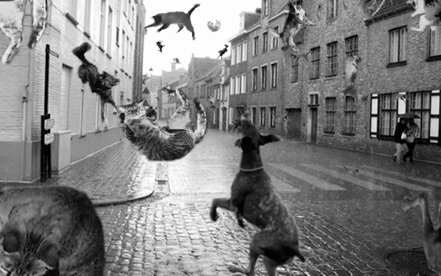
It is a curious phrase that has no clear origin, but I was talking with a correspondent in London this week about an incoming Saharan sand storm — same as last year which covered cars and streets with fine dust — asking if there had been any strange insects delivered in the storm? The answer was no, not even any scorpions to rescue.
Researching the subject I did find this list of strange things delivered by storms:—
Fish
Singapore, February 22, 1861
Madhesh, Nepal, May 15, 1900
Moose Jaw, Saskatchewan, Canada, July 1, 1903[
Marksville, Louisiana, October 23, 1947
Kerala, India, February 12, 2008
Bhanwad, Jamnagar, India, Oct 24, 2009
Lajamanu, Northern Territory, Australia, February 25 and 26, 2010,
Loreto, Agusan del Sur, Philippines, January 13, 2012
IIT Madras, Chennai, Tamil Nadu, Sep 12, 2013
The yearly Lluvia de Peces in Yoro, Honduras
Chilaw, Sri Lanka, 6 May 2014,
Nandigama, India, 19 June 2015,
Guntur, India, 16 August 2015
Spiders
Santo Antônio da Platina, Brazil, February 3, 2013.
Frogs and toads
Ishikawa Prefecture, Japan, June 2009 (occurrences reported throughout the month)
Rákóczifalva, Hungary, 18–20 June 2010 (twice)
Others
Jellyfish, Bath, England, 1894
Worms, Jennings, Louisiana, July 11, 2007]
100 Million Super-Rats

PEST control experts have warned homeowners in Cornwall to expect an 'alarming' growth in the population of so-called super rats during the run-up to Christmas.
The British Pest Control Association is worried that numbers of the rodents, which have grown resistant to conventional poison, could soar in the next few months boosted by a combination of colder temperatures and increasingly wet weather.
The leading trade body says the spread of the rats has been accelerated by failed home treatments, which have helped them to grow bigger and stronger and build up their immunity. Many 'over-the-counter' remedies are now ineffective, and the body insists control of the rodents has become a matter for professionals. The population of rats resistant to poison has increased rapidly in recent years due to a naturally-occurring mutation of genes.
Estimates put the current rat population at more than 100 million. They carry bugs which can be passed to humans, including Weil's disease, which can lead to jaundice and kidney failure. Simon Forrester, chief executive of the BPCA, said: "Reports of poison-resistant rats have been increasing in recent years and it seems likely that there'll be a further surge in numbers during the coming months. "There's less natural food around during colder weather so the population of rodents in and around homes and business premises could swell at an alarming rate as we head into winter. "The trouble is that people who try to treat problems themselves are likely to be making the problem worse.
"The rodents have become resistant and, in some cases, immune to off-the-shelf poisons to the point where they're actually feeding off the toxic pellets, which means their size and strength is increasing."
A typical home may have more than a dozen potential entry points for the rodents. They get through gaps as small as 15mm, often using plumbing pipes and unscreened vents or gaps in the eaves and roof edges. Mr Forrester added: "The first evidence of rats in a home is often noises under the floor, in the walls or loft as that's where most will head to once they're inside. "Quite apart from the health risks, they'll foul water tanks and chew on wood or electrical wires which can cause a lot of damage and poses a fire hazard. "They'll also do their best to find sources of food, which means they can soon move to other areas of the house occupied by humans. "Rats also breed rapidly and will create nests in attics or walls, so it's vital to act as soon as any evidence is found."
For tips on precautions which can be taken to reduce the risk of an infestation or to find a pest controller in your area, visit www.bpca.org.uk
Important Medical advice
on alcohol and fats

Getting to know her here

First, a disclaimer — this is not a joke, and its about as far from April 1st as you can get. — This is the serious suggestion of Jeb Bush for the $10 bill. The BBC reports:—
US Republican presidential hopeful Jeb Bush has picked the UK's former Prime Minister, Margaret Thatcher, as his choice for the face of the $10 bill.
The former Florida governor made the surprise suggestion during a televised debate for the top Republicans vying for the presidential nomination.
All 11 candidates were asked who they would choose, now the US Treasury has announced plans to put a woman on the redesigned note.
Mr Bush's choice drew applause.
"I would go with Ronald Reagan's partner, Margaret Thatcher," he said, noting it was "probably illegal" and unlikely to happen because she is not American.
But he added: "A strong leader is what we need in the White House, and she certainly was a strong leader that restored the United Kingdom into greatness."
He was not the only Republican to pick a foreigner to grace the new note, which comes into circulation in 2020.
Mother Teresa was the choice of Ohio Senator John Kasich.
Two candidates picked civil rights heroine Rosa Parks, while rising star Carly Fiorina dismissed the question as gesture politics.
Weird Tunnels

The Daily Mail, an English newspaper recently ran this article:—
Was this tunnel network built to be the final refuge of a death cult?
Inside the bizarre 200-year-old labyrinth under Liverpool that has experts baffled
Mystery has surrounded Liverpool's secret tunnel network for centuries
They were built by eccentric philanthropist Joseph Williamson in 1800s
Experts are baffled to true purpose but some suggest he was part of a cult
Others think he may have built them to keep local men in employment
Built around 200 years ago, they stretch on for miles creating a vast subterranean labyrinth of twisting routes and caverns. Yet little is known about the forgotten tunnels, which were only rediscovered in 2001.
They were created by the rather eccentric Joseph Williamson, a successful tobacco merchant, who was incredibly secretive about the build throughout his lifetime.
Fortunately, George McNamara, Vermont Views’ Science Correspondent is on the scene to determine what’s what — his report forthcoming as soon as he emerges from the underground laryrinth, unless it is one of those weird-science things and he comes out on a parallel planet in parallel Liverpool, one without The Beatles, but with free cups of tea and where it hardly ever rains.
Your Fortune and a Little Survey
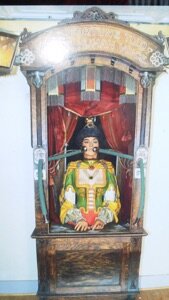
Meanwhile here is a small selection from my researches where I discovered that there are even kits available so that you can make your own. The text may not match the images, but at least I could find the Mystic Zoltar below.
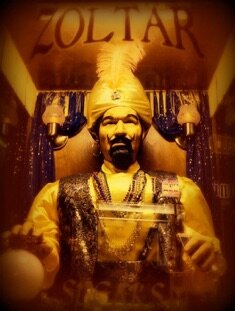
It features a recorded voice and eerie animatronics. "The 100-year-old fortune teller was an extremely rare find. Instead of dispensing a card like Zoltar, the Gypsy would actually speak your fortune from a hidden record player. When you dropped a penny in the slot, her eyes would flash, her teeth would chatter and her voice would come floating from a tube extending out of the eight-foot-tall box.
This machine also provided fortunes for males and females separately. Reportedly, magician David Copperfield tried to buy the machine from the Montana State Historical Commission for two million dollars.
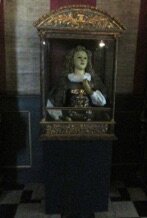

Madame Zita is a richly attired fortune teller in gypsy style. The electric version was manufactured around 1905 by the Roover Brothers.
Grandmothers Predictions (Cleveland Grandma) - William Gent Mfg, c. 1929 - The wise old grandmother passes her hands over the fortune telling cards and stops at the proper fortune. The card falls into the tray below.
Princess Doraldina - Doraldina Corp, c. 1928 - Her youth and beauty attract the arcade customer. The machine's lifelike movements when granting fortunes make the process appear to be alive.
Geneco Gypsy Grandma Fortune Teller - Geneco Mfg., New York. NY c. 1940s-1950s- The central attraction of the original boardwalk and arcades was the "Gypsy Grandma" that comes to life after depositing a coin into a slot. Once a selection is made using a rotary dial that illuminates the player's astrological sign of choice, the animated gypsy fortune teller moves her head above a lighted crystal ball while holding a fan of playing cards in her right hand and magic wand in her left hand. Featured sophisticated movements (nods, turns her head, breathes). Her right hand picks-up a fortune card from the enclosure that she opens with her left hand. She brings the card in front of her, turns her head, and then moves the card over the cauldron and drops it (which delivers the card to the patron).

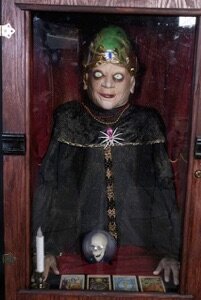
Mike Munves Deco “Ask Grandma” Fortune Teller. - Mike Munves Corp., New York, - Ask Grandma Fortune Teller, Deco. Full size Grandma, life size with human movements (chest, both hands, eyes, head). The crystal ball glows once coin is inserted. She will scan the cards for a peek into your future, and then a fortune card will drop for the patron.

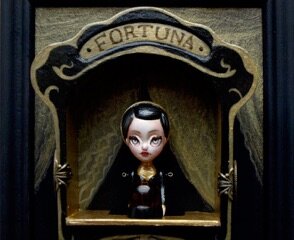
Zoltan Fortune Teller - Deposit 25 cent coin, put receiver in your ear, press one of twelve zodiac sign button on the front of the machine(corresponds to the 12 signs of the zodiac). The crystal ball is lit by an eerie, red mystic light when Zoltan predicts fortune. Offers 1 to 12 Zoltan`s fortunes in a heavily Hungarian accent. Zoltan usually begins his fortune telling with "This is Zoltan speaking" or "Greetings from Zoltan". The predictions, which last around one minute, include things about your future, lucky numbers, and favorable colors.
When is a light-bulb not a right-bulb?

An on-line friend passed on this message:
GOOD TO KNOW INFO from the FIRE DEPARTMENT:
Captioned is a picture of a CFL light bulb from my bathroom. I turned it on the other day and then smelled smoke after a few minutes. Four inch flames were spewing out of the side of the ballast like a blow torch! I immediately turned off the lights. But I'm sure it would have caused a fire if I was not right there. Imagine if the kids had left the lights on as usual when they were not in the room.
I took the bulb to the Fire Department to report the incident. The Fireman wasn't at all surprised and said that it was not an uncommon occurrence. Apparently, sometimes when the bulb burns out there is a chance that the ballast can start a fire. He told me that the Fire Marshall had issued reports about the dangers of these bulbs.
Upon doing some Internet research, it seems that bulbs made by“Globe” in China seem to have the lion’s share of problems. Lots of fires have been blamed on misuse of CFL bulbs, like using them in recessed lighting, pot lights, dimmers or in track lighting. Mine was installed in a normal light socket.
I bought these at Wal-Mart. I will be removing all the Globe bulbs from my house. CFL bulbs are a great energy saver but make sure you buy a name brand like Sylvania , Phillips or GE and not the ones from China .
Double Duh!

A South African pen manufacturer has apologised after its “empowering” message to women urging them to look like a girl and think like a man caused outrage on social media.
Bic South Africa posted the ad on its Facebook page to celebrate national women’s day. Showing a smiling woman in a suit with arms folded, it read: “Look like a girl, act like a lady, think like a man, work like a boss #HappyWomensDay.”
The post was eventually deleted as commentators expressed disgust. “Look like a girl?’ Because the infantilisation of women and the sexualisation of children is exactly the kind of blurred line we need!”, read one, the Sunday Times in Johannesburg reported.
“Why am I expected to look like a child? Why am I expected to see the world through a masculine lens? Why am I expected to ‘think like a man’ but not expected to ‘act like a man’ on my so-called manly thoughts?” wrote another.
Pioneering on the smallest democracy in the world, Pitcairn, Pop. 48

One interesting fact about Pitcairn is that the population of 48 people had voted some time ago to permit gay marriages. Earlier in its history Pitcairn Island became a British colony in 1838, and was among the first territories to extend voting rights to women.
Pitcairn Island was sighted on 3 July 1767 by the crew of the British sloop HMS Swallow, commanded by Captain Philip Carteret. The island was named after Midshipman Robert Pitcairn, a fifteen–year–old crew member who was the first to sight the island. Robert Pitcairn was a son of British Marine Major John Pitcairn, who later was killed at the Battle of Bunker Hill in the American Revolution.
In 1790, nine of the mutineers from the Bounty, along with the native Tahitian men and women who were with them (six men, eleven women and a baby girl), settled on Pitcairn Islands and set fire to the Bounty. The wreck is still visible underwater in Bounty Bay, discovered in 1957 by National Geographic explorer Luis Marden. Although the settlers survived by farming and fishing, the initial period of settlement was marked by serious tensions among them. Alcoholism, murder, disease and other ills took the lives of most mutineers and Tahitian men. John Adams and Ned Young turned to the scriptures, using the ship's Bible as their guide for a new and peaceful society.
The Pitcairn Islands has the smallest population of any democracy in the world.
What’s on your desktop?

I am curious to know what other people have on their desktop as wallpaper. For myself, I haven’t been able to replace this image for a long time — it is of course a Scottish Loch with single house and where I wouldn’t mind waking up, now and again.
50th Python Reunion
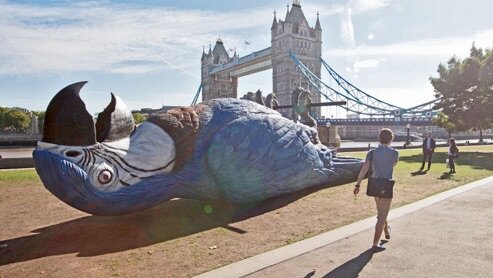
The Monty Python reunion in London began on July 1, and after a 10-day break, picks up again tonight at the O2 Arena for the final five nights that will see Eric Idle, John Cleese, Terry Gilliam, Terry Jones, and Michael Palin on the same stage together, doing silly things one more time. Of course, it's not all silliness—the first five-night run of the performance raised more than £20,000 for five different charities chosen by the Python members, by giving those charities the opportunity to auction off the right to perform in a sketch alongside the cast.
To celebrate the achievements of the Monty Python crew, UKTV channel Gold—which will air the final performance of the reunion on Sunday—contracted with sculptor Iain Prendergast to create a 50-foot fiberglass version of the famous "Norwegian Blue" parrot. The parrot, which is famous for being dead from the moment it was sold, was placed on Monday at Potters Fields Park in South London, near Tower Bridge. This is both a fine reminder to tune in on Sunday to the broadcast and an outstanding opportunity to inspire countless visitors to declare in increasingly frantic tones that "This parrot is no more! It has ceased to be! It’s expired and gone to meet its maker! This is a late parrot! It’s a stiff!" Because if there’s anything that you need to commission a 50-foot fiberglass sculpture to get people who know every word to famous Monty Python sketches to do, it’s to recite the funnier bits of those sketches to anyone within earshot.
Easter Eggs — and the Anglo-Saxon goddess of light
The link between eggs and Easter derives from the Christian tradition of fasting through Lent, the 40 days before Easter Sunday, when the eating of animal products, including eggs, was strictly forbidden. However, hens continued to lay throughout the fast, resulting in a particularly large stock for Easter Sunday.
For many families, Easter Sunday began with a breakfast of elaborately decorated eggs. The custom of exchanging decorative eggs continues today in many countries around the world.
Children in the UK receive an average of 8.8 Easter eggs every year – double their recommended calorie intake for a whole week.
The largest ever Easter egg hunt was in Florida, where 9,753 children searched for 501,000 eggs.
When people gorge on a chocolate Easter bunny, 76 per cent bite off the ears first, 5 per cent go for the feet and 4 per cent opt for the tail.
Households spend an average of £75 on Easter each year.
Sales at Easter time make up 10 per cent of UK chocolate spending for the whole year.
The UK's first chocolate egg was produced in 1873 by Fry's of Bristol.
The tallest chocolate Easter egg was made in Italy in 2011. Standing 10.39 metres tall and weighing 7,200 kg, it was taller than a giraffe and heavier than an elephant. But Portugal is the home of the largest decorated Easter egg, which reached almost 15m in height and 8m in diameter when it was made in 2008.
Almost one in five children (19 per cent) say they've made themselves ill by eating too much chocolate over the Easter holidays.
The name Easter owes its origin to Eostre or Eastre, an Anglo-Saxon goddess of light and the dawn who was honoured at pagan festivals celebrating the arrival of spring.
In medieval times, a festival of egg throwing was held in church, when the priest would throw a hard-boiled egg to one of the choirboys. It was then thrown from one boy to the next and whoever held the egg when the clock struck 12 was the winner and could keep it.
The custom of giving eggs at Easter has been traced back to Egyptians, Persians, Gauls, Greeks and Romans, for whom the egg was a symbol of life.
Chocolate woes:—
In west Africa, cocoa workers scratch a living on small farms, usually no bigger than five hectares. Years of low incomes, uncertainty over land rights and ageing cocoa trees passing their most productive years have shaped an industry ravaged by poverty and child labour. The average farmer in Ivory Coast earns just 6.6% of the price of each tonne of cocoa sold on world markets, according to the Cocoa Barometer 2015, a report by a coalition of campaign groups. Another NGO, the International Labor Rights Forum, estimates that up to 1.5 million children work in the industry because low wages deter adults from taking jobs in cocoa farming.
With little prospect of being able to support a family on cocoa, young west Africans are opting to plant more lucrative crops, such as rubber, or moving to find work in cities. The average cocoa farmer in Ivory Coast earns $2.07 a day – roughly the same as the cost a single bar of chocolate in that country.
Not surprisingly many farmers working in this £80bn industry have never tasted a square of chocolate – far less a hand-finished Belgian chocolate Easter egg. Last year a video of an Ivory Coast farmer eating chocolate for the first time became an internet sensation.
“In the next five years the price of chocolate will skyrocket, and we should think about it as very much a luxury,” said Alejandro Litovsky, founder of consultancy Earth Security Group. In a recent report, Earth Security forecast a cocoa shortfall of a million tonnes by 2020. This echoes a warning from the world’s biggest cocoa grinder, Swiss listed firm Barry Callebaut, of “potential cocoa shortages in 2020”. Last year Mars and Hershey, which together account for two-thirds of US chocolate sales, increased the prices of their namesake bars, and of the Snickers, Maltesers and Bounty brands.
Clet, the Lone Ranger
An adventurous, long-distance travelling dolphin who has captured the imaginations of people around the world has been spotted off Falmouth [illus.]

Clet, a bottlenose dolphin named by French fisherman whose boats he used to follow around, has popped back over to Cornish waters after spending some time around Scotland, the Isle of Man and Dorset.
Caz Waddell, acting marine conservation manager from Cornwall Wildlife Trust, said: "We're very lucky in Cornwall that bottlenose dolphins can be seen quite regularly all around our coasts.
"However, Clet is somewhat unique; a bit of a lone ranger. His travels throughout the UK and Europe are truly remarkable, and the best part is that the majority of his movements have been tracked simply by members of the public sending in photographs."

Ruth Williams, marine conservation manager from Cornwall Wildlife Trust, said: "Clet has been seen in five countries since he was first recorded in 2008. The fact that he travels such large distances really challenges our understanding of the species, and also highlights the need for international collaboration when monitoring and protecting these highly mobile marine mammals."
Have you seen Clet? Send in your marine wildlife sightings to Cornwall Wildlife Trust by phone to 01872 273939 or online at www.cornwallwildlifetrust.org.uk/marinesighting.
Mrs. Adams

It is a curious thing reading on John Adams’ second visit to Europe when his wife Abigail joined him, and where in France they both entertained Jefferson. Abigail seemed to Jefferson the complete intellectual and even political equal of her husband, and having never before met a woman ‘with a mind’ could only refer to her as ‘androgynous.’ This was not a sexual reference as much as a gender one, and a significant indicator of the life of their times that even Jefferson’s lexicon contained no words for ‘intelligent woman.’
ABIGAIL SMITH ADAMS, Born at Weymouth, Massachusetts in 1744, November 11
Upper illustration ‘during the revolutionary period,’ and below, during her stay in France.
Not long after Adams had been elected, Mrs. Adams even compared the prospect of becoming First Lady to being “fastened up hand and foot and tongue to be shot at as our Quincy lads do at the poor geese and turkies.” She elaborated further, in another letter at the time: “ I have been so used to freedom of sentiment that I know not how to place so many guards about me, as will be indispensable, to look at every word before I utter it, and to impose a silence upon myself, when I long to talk.” — A letter written by Abigail Adams to her sister in 1799 while she was the second First Lady. (Library of Congress)
“ I expect to be vilified and abused, ” Mrs. Adams admitted in still another letter. “ When I come into this situation…” When her friend and fellow feminist Mercy Otis Warren wrote to Abigail Adams congratulating her on being thrust into “ this elevated position ” as the most politically prominent woman in the United States, the new First Lady responded on the day her husband became president that, “ I shall esteem myself peculiarly fortunate, if, at the close of my public life, I can retire esteemed, beloved and equally respected with my predecessor."
The Mystery of Indian Queens
In late 1609, an injury from a gunpowder explosion forced Smith to return to England for medical care. The English told the Powhatans that Smith was dead. Pocahontas believed that account and stopped visiting Jamestown. Much later, she learned that he was living in England when she traveled there as the wife of John Rolfe.
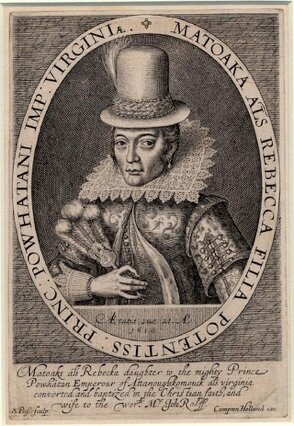
The Virginia Company of London had long seen one of its primary goals as the conversion of Native Americans to Christianity. With the conversion of Pocahontas and her marriage to an Englishman–all of which helped bring an end to the First Anglo-Powhatan War–the company saw an opportunity to promote investment. The company decided to bring Pocahontas to England as a symbol of the tamed New World "savage" and the success of the Jamestown settlement. In 1616, the Rolfes traveled to England, arriving at the port of Plymouth on June 12. They journeyed to London by coach, accompanied by a group of about eleven other Powhatans, including a holy man named Tomocomo.
A number of stories try to explain who the Indian Queen was. Each version agrees that the name comes from the name of a coach/post house or inn. The name cannot be traced earlier than the 19th century. The inn was built on a plot of land known as White Splat in the late 18th century. The Indian Queen Inn stood beside the road leading from Goss Moor to Fraddon, just below the top of the hill. The pub had a small porch and displayed as a sign the portrait of an Indian queen. An inscription on the porch told the story of a Portuguese princess who landed at Falmouth in packet days, and slept one night at this inn on her way to London. Her swarthy appearance gave onlookers the impression that she was an Indian.
It has also been suggested that the royal lady was Pocahontas (1595–1617), an American Indian who was the younger daughter of Powhatan, chief of the Indian tribes who lived along the Virginia coast. There is very little evidence to support this story; nevertheless, it is still commonly given as the origin of the name. Pocahontas's name has been given to a modern street in Indian Queens known as Pocahontas Crescent.
Up to April 1780, the inn had the name "The Queen's Head". Sometime thereafter, and definitely by 1787, it had become "The Indian Queen". It seems that the name became "The Indian Queens" around the end of the 18th century.[citation needed] The signboard displayed an American Indian on one side and Victoria as Queen of India on the other. (Queen Victoria reigned 1837–1901; from 1877 she was Empress of India.) The pub was demolished in the 1960s and its old signboard resides in the Truro Museum. In 2009 the old stone lintel from the pub re-appeared on a house in Indian Queens not far from the site of the original pub. It bears the inscription
"THE INDIAN QUEEN
LICENSED BREWER AND RETAILER OF BEER, CYDER, WINE, AND TOBACCO.
LICENSED to the POST HORSES"
As to her relationship with Captain Smith, She was about 10 years old and Smith was a grown man and they formed an affectionate friendship. There is no evidence to support the later suggestions, as used by Disney, that there was any romantic involvement. In view of their age difference had there been any such relationship it would not have been a sweet romance.
The Virginia Company decided to raise more funds via a lottery and called Sir Thomas Dale to England. He brought Pocahontas, John and Thomas and a dozen or so members of the Algonquian tribe, including Pocahontas’s sister Matachanna and her husband Uttmatomakkin who was one of the religious leaders of the tribe. Some old English sources, having difficulty with his correct name, refer to him as Tomocomo.
They set sail in Argall’s ship, the George, the same one where Pocahontas had been held prisoner and they landed at Plymouth in the spring of 1616.

In March 1617, Rolfe and Pocahontas boarded a ship to return to Virginia; the ship had only sailed as far as Gravesend on the river Thames when Pocahontas became gravely ill. She was taken ashore and died in John Rolfe's arms at the age of twenty-two. It is not known what caused her death, but theories range from smallpox, pneumonia, or tuberculosis, to her having been poisoned. According to Rolfe, she died saying, "all must die, but tis enough that her child liveth". Her funeral took place on March 21, 1617, in the parish of Saint George's, Gravesend.[60] The site of her grave is thought to be underneath the church's chancel, though since that church was destroyed in a fire in 1727 her exact gravesite is unknown. Her memory is honored with a life-size bronze statue at St. George's Church by William Ordway Partridge.
The Pirate Queen of Ireland
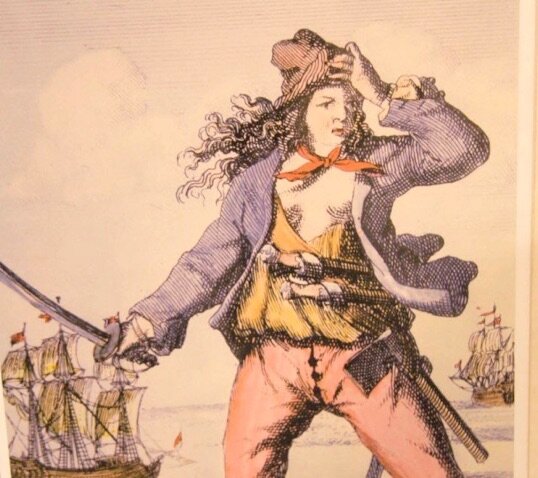
1. Granuaile / Gráinne Uí Mháille / Grace O’Malley
There is not a single mention of this bold and wily chieftain in official Irish historical records, probably because she was 1) a woman and 2) very pragmatic, and tended to side with whoever would keep her clan in power. Not exactly inspiring for later Irish rebels. But stories of her feats in the 16th century were preserved in the folk tradition and in official English records: Grainne was the annoying lady with the cunning ability to steal all their gold.
She was the only child of the chief of the O’Malleys, who ran the area of the Irish west coast now known as County Mayo. She captained a fleet of fishing boats that frequently turned into pirate ships, mostly when English ships swung too close to the Irish coast. She hit her peak after she outlived her first husband and married the chief of the Bourke clan at 36; he became her second–in-command, of course.
The coolest thing ever: when Grainne was in her 60s, she negotiated with Queen Elizabeth I—in Latin. The two powerhouses agreed to partner up against some of the more bothersome Irish clans. This was bad for the cause of Irish freedom, but quite good for Grainne herself. Although plenty of balladeers in the following centuries slapped her name onto nationalist poems and songs, the leader of the O’Malleys was a pirate and a tribal leader first, and a very tough broad. Anne Chambers’s biography Granuaile: The Irish Pirate Queen is the only real, thorough history of her life, if you can still find it.
Scots Ice Cakes

As temperatures fall along the River Dee in Aberdeenshire, Scotland, each winter, it's not unusual for visitors to find foam freezing on the surface.
This month, however, River Dee Trust Biologist Jamie Urquhart discovered dozens of pancakelike pieces of ice floating along the historic river. (Photo/River Dee Trust, Jamie Urquhart)
"What we think happened is this: Foam floating about on the water started to freeze, probably at night," Dee Catchment Outreach Officer Joanna Dick said.

This is the first time the ice pancakes have been spotted on the River Dee. They are more commonly seen in the Antarctic or the Baltic Sea.
Below-normal temperatures for the month of December may have aided in their formation.
December temperatures in Aberdeenshire have averaged 1 degree Celsius (1.4 F) below normal. Almost every night this month, lows have dropped below freezing.
"They are a rare occurrence and conditions have to be right for them to form," Dick said.
Bowthorpe Oak

A GIANT OAK TREE at Bowthorpe Park Farm, Manthorpe, on the A6121, three miles south west of Bourne, has earned a place in the Guinness Book of Records and in 1998 was the subject of a short film on television about its size and longevity.
The tree stands in a grassy meadow behind the farmhouse and visitors can see it for a small charge that is donated to charity. The legendary Bowthorpe Oak is the largest girthed living British oak and its circumference measures almost forty feet. Apart from its great size, it has a rugged bole, gnarled and crooked branches and a great spread of crown. It is reputed to be well over 1,000 years old and may therefore have been planted during the time of William the Conqueror (1066-1087) but chains now bind it to prevent it from splitting under the weight of its heavy boughs.
There is sufficient space within the hollow trunk to hold a party and one former tenant of the farm had a roof and a door installed and used the recess as an additional room in which 39 people have stood at one time and 13 have sat down comfortably to tea while successive generations of children born and raised on the farm have played in its branches. There are many other tales about the uses to which the tree has been put. One former owner used to feed his small calves inside the trunk while children from the Methodist chapel at nearby Manthorpe held their annual tea and treat there.
Bowthorpe Park Farm enjoys a beautiful setting on the side of a hill with a stone farmhouse that is over 400 years old. The surrounding area was originally Bowthorpe Park, hence the name of the farm, and in 1226, Sempringham Priory acquired the manorial chapel which stood there but it has gone, together with its accompanying manor house. The grass in the parkland that remained was lifted during the Second World War and the land cultivated as part of the drive to produce more food for home consumption. Manthorpe village can be seen a few fields away on the next hill and there is an attractive pond alongside the entrance track to the farm. The family who now run the farm welcome visitors throughout the year to take a look at their activities and their busiest period is during the lambing season in the spring, a favourite time for school parties.


